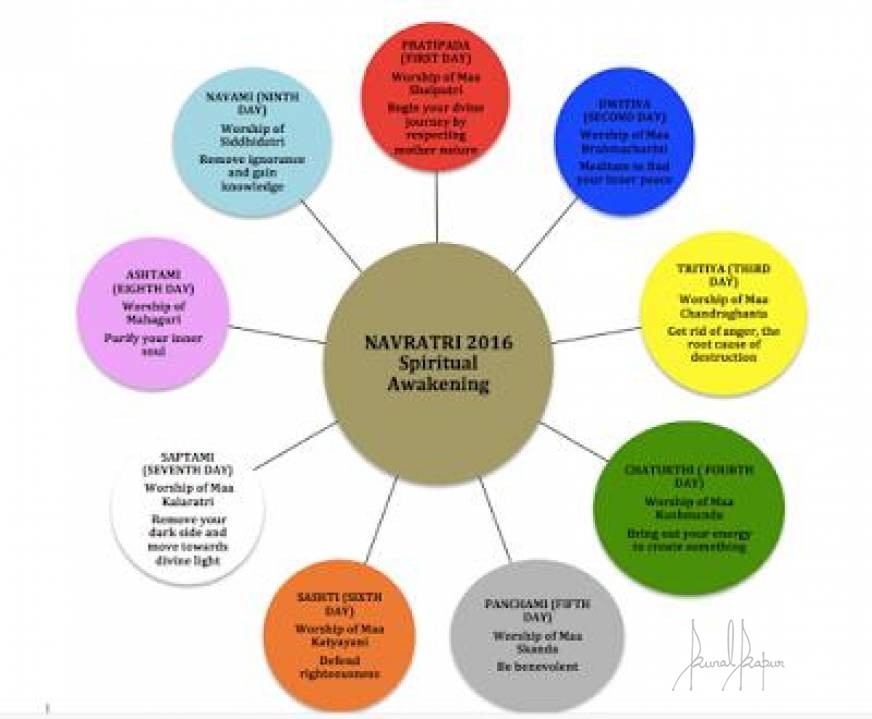What is Navratra? Is it feasting or fasting? — By Kunal Kapur
Understanding Navratri is very important even before we practise it. Vrat during navratri is practiced to keep away worldly pleasures and connect with oneself. Vrat is also about sticking to very basic, bland food that is just about enough to keep you going. It amuses me how people overindulge on vrat khana and defy the very substance of a fast. To top it up restaurants offer unlimited navratra thalis to excite people to dine out and eat belly full. Is Navratri for Fasting or for Feasting?
True essence of #Navratri is to cleanse oneself with purity and removal of darkness with the light of knowledge and meditation. Beautifully explained below what each day of Navratri stands for.
Have you feasted enough during Navratra? Shocked!!! Don’t be, because most of us nowadays misunderstand the concept of fasting.
Why do we fast?
As most devout Indians, many of us believe in fasting on special occasions. Be it an Ekadashi ka vrat or Janmashtami. But you need to understand the significance of fasting. As most of us know, it is a way to connect to God, but how? Fasting in Sanskrit is called Upavaasa. Upa means “near” and vaasa means, “stay”. Thus, an Upavaasa brings us closer to the Almighty.
Here’s how.
Preparing and consuming food is a very essential part of our daily lives. How often are we so engrossed in this task, that we forget that there are other aspects too in our life. Fasting is a gentle reminder that from Live to Eat we should switch to Eat to Live motto.
Also fasting gives our body a much-needed break. It cleanses and detoxifies itself in the fasting period. You feel rejuvenated and your mind is active too. It is a time when your concentration improves and you can meditate better.
However, fasting should not make us weak or we should not crave for indulging into food later. It is a period of self-control, wherein light food gives you enough nourishment to carry on with your daily tasks. It ensures that you keep your integrity intact and carry on with the ritual. Also as it is a self-imposed regime, it should be followed by heart and not purely because someone imposes it, as the latter kills the essence of fasting.
Thus, fasting should be followed by consuming simple food to sublimate our desires.
.jpeg) How often nowadays in Navratras you see so many food outlets enticing you with a fancy Navratra thali. Some even go to the extent of satisfying your non-veg pangs (which you only opt out for JUST nine days, and that too voluntarily) by advertising navratri special mock duck dishes. Really! Don’t you think that the very purpose of fasting is lost here?
How often nowadays in Navratras you see so many food outlets enticing you with a fancy Navratra thali. Some even go to the extent of satisfying your non-veg pangs (which you only opt out for JUST nine days, and that too voluntarily) by advertising navratri special mock duck dishes. Really! Don’t you think that the very purpose of fasting is lost here?
Navratara is the time to detoxify and cleanse our system and not to indulge. Food prepared in navratras should be simple, without any processed ingredient and with minimum spice and oil.
So how do you justify all those fried pakoras and puris and over indulgent sweet dishes?
Keep these simple tips in mind when fasting.
- First and foremost, don’t starve yourself. For if you are hungry you tend to get your hands on anything edible, regardless of nutrition.
- Keep some snacks handy like roasted makhana or nuts.
- Instead of all the fried fare, try baking or grilling food.
- Indulge in fruits to give you a healthy dose of vitamins.
- Sendha namak is like a digestive for your food. It also enhances the flavor of your dish.
- Drink plenty of water. Not only it cleanses your system, but it also controls your hunger pangs. It also keeps your digestion in check.
- Increase your calcium intake by consuming delicious yoghurt. It cools your body too.
Navratri & Ayurveda
Have you ever thought about the timing of Navratras? How and why they occur twice a year at the time when the season is about to change? Why are we forbidden to eat onion, garlic and certain grains and refrain from meat and alcohol? According to Ayurveda, these food don’t go well when our body is experiencing seasonal change. Thus to maintain our physical and mental balance we need to cleanse our bodies.
Navratras, or nine nights, are divided into three phases of three days each. This division is based on the three gunas (attributes) highlighted by Ayurveda.
They are:
Sattva – It means one that is pure, natural, vital, energetic, clean, conscious, strong, true, honest and wise.
Rajas – It means one that is agitated, sensual, passionate, moving and emotional.
Tamas – It means one that is dark, destructive, spoiled, ignorant, stale, inert, unripe, unnatural, weak and unclean.
The aim of Navratras is to gradually reduce the Tamasic attributes and gain Saatvik qualities. Thus in these nine day fasting period, starting from Tamasic diet, we move to Rajasic and eventually reach the ideal Saatvik diet.
And remember, diet is only a supporting tool for our soul cleansing. The aim is to clean and make our soul pure, devoid of any destructive attributes.

